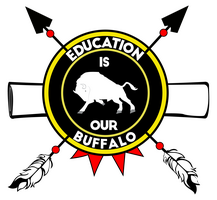The Talking Stick is a tool used in many Native American Traditions when a council is called. It allows all council members to present their Sacred Point of View. The Talking Stick is passed from person to person as they speak and only the person holding the stick is allowed to talk during that time period. The Answering Feather is also held by the person speaking unless the speaker address a question to another council member. At that time, the Answering Feather is passed to the person asked to answer the query. Every member of the meeting must listen closely to the words being spoken, so when their turn comes, they do not repeat unneeded information or ask impertinent questions. Indian children are taught to listen from age three forward; they are also taught to respect another's viewpoint. This is not to say that they may not disagree, but rather they are bound by their personal honor to allow everyone their Sacred Point of View.
People responsible for holding any type council meeting are required to make their own Talking Stick. The Talking Stick may be used when they teach children, hold council, make decisions regarding disputes, hold Pow-Wow gatherings, have storytelling circles, or conduct a ceremony where more then one person will speak.
Since each piece of material used in the Talking Stick speaks of the personal Medicine of the stick owner, each Talking Stick will be different. The Qualities of each type of Standing Person (Tree) brings specific Medicine. White Pine is the Peace Tree, Birch symbolizes truth, Evergreens represent the continued growth of all things. Cedar symbolizes cleansing. Aspen is the symbol for seeing clearly since there are many eye shapes on the truth. Maple represents gentleness. Elm is used for wisdom; Mountain Ash for protection; Oak for strength; Cherry for expression, high emotion, or love. Fruit woods are for abundance and walnut or pecan for gathering of energy or beginning new projects. Each person making a Talking Stick must decide which type of Standing Person (Tree) will assist their needs and add needed medicine to the Councils held.
The ornamentation of each stick all have meaning. In the Lakotah Tradition, red is for life, yellow is for knowledge, blue is for prayer and wisdom, white is for spirit, purple is for healing, orange is for feeling kinship with all living things, black is for clarity and focus.
The type of feathers and hide used on a Talking Stick are very important as well. The Answering Feather is usually an Eagle Feather, which represents high ideals, truth as viewed from the expansive eye of the eagle, and the freedom that comes from speaking total truth to the best of one's ability. The Answering Feather can also be the feather of a Turkey, the Peace Eagle of the south, which brings peaceful attitudes as well as the give and take necessary in successful completion of disputes. In the Tribe that see Owl as good Medicine, the Owl feather may also be used to stop deception from entering the Sacred Space of the Council.
The skins, hair or hides used in making a Talking Stick brings the abilities, talents, gifts and medicine of those creatures-beings to council in a variety of ways. Buffalo brings abundance; Elk brings physical fitness and stamina; deer brings gentleness; rabbit brings the ability to listen with big ears; the hair from a horse's tail or mane brings perseverance and adds connection to the earth and to the spirits of the wind. If an illness of heart, mind, spirit, or body has affected the group gathering, snake skin may be wrapped around the Talking Stick so that healing and transmuting of those poisons can occur. The Talking Stick is the tool that teaches each of us to honor the Sacred Point of View of every living creature.
Go Back To: Unknown Nation
